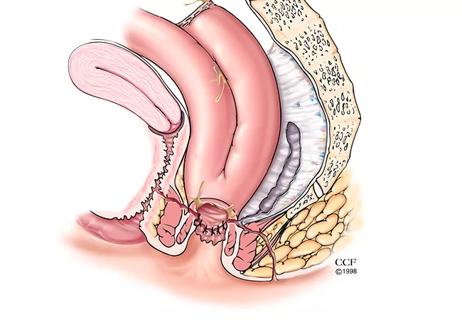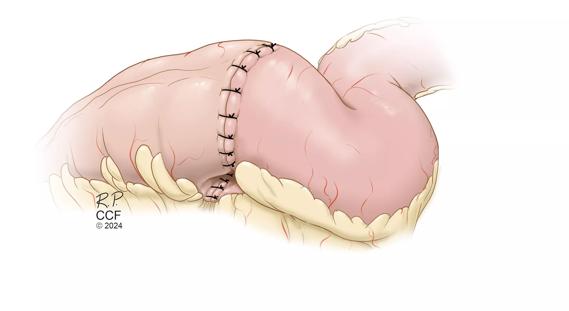Retrospective analysis looks at data from more than 5000 patients across 40 years

Although ileal pouch-anal anastomosis (IPAA) procedures have been a game-changer for patients with ulcerative colitis (UC), indeterminate colitis (IC), Crohn’s disease (CD), and hereditary polyposis syndromes, many patients do not fully understand the impact the procedure can have on quality of life (QoL). A new study in the Journal of Gastrointestinal Surgery looks at more than 40 years’ worth of data to better understand surgical outcomes, patient satisfaction and postoperative QoL of patients who underwent a pelvic pouch procedure.
Advertisement
Cleveland Clinic is a non-profit academic medical center. Advertising on our site helps support our mission. We do not endorse non-Cleveland Clinic products or services. Policy
“Before IPAA, patients with UC, IC, CD or polyposis typically required a permanent ileostomy, which obviously has a major impact on one’s quality of life,” says Olga Lavryk, MD, PhD, lead author of the study and a colorectal surgeon in Cleveland Clinic’s Digestive Disease Institute. “Since the introduction of IPAA in the late 1970s, there have been several advances to the procedures, including a minimally invasive approach, enhanced recovery programs and shorter hospital stays. We know that IPAA is associated with high QoL and health, but there haven’t been any studies reporting on how patients' QoL, satisfaction and happiness with the procedure evolve.”
The retrospective analysis relied on a prospectively maintained ileal pouch database to identify all patients who underwent index IPAA at the Department of Colorectal Surgery, Cleveland Clinic between 1983 and 2022. Patients were stratified by diagnoses, which included medically refractory UC, IC, Crohn colitis (CD), cancer/dysplasia (C/D), and familial adenomatous polyposis (FAP). The C/D group also included patients with inflammatory bowel disease (IBD; CD, UC, or IC)-associated dysplasia or adenocarcinoma.
“At Cleveland Clinic, patients are seen annually for follow-up,” says Dr. Lavryk. “During their visit, patients are asked to complete the Cleveland Clinic Pelvic Pouch Questionnaire (CCPPQ). We analyzed their responses from one, five, 10, 15 and 20 years after surgery.”
The self-administered questionnaire collects information about stool frequency, seepage, use of pads, urgency and incontinence. The questionnaire also asks about social, work, dietary, or sexual restrictions.
Advertisement
Overall, 5070 patients were included in the study. Of these patients, 3424 (67%) were diagnosed with UC, 923 (18%) were diagnosed with IC, 260 (5%) with FAP, 237 (5.2%) with IBD-dysplasia, 177 (4%) with CD and 49 (1%) were diagnosed with other.
The median age at the time of IPAA was 38.7 ± 13.7 years. Patients with FAP were the youngest (31.1 ± 12.2 years) at the time of IPAA, and patients in the IBD-dysplasia group were the oldest (48.4 ± 14.0 years) at the time of IPAA.
More than half the patients with IBD (1760 [51%] in the UC group and 543 [59%] in the IC group) had a 3-stage IPAA because of the nature of the disease or poor patient health. Fewer patients in the UC and IC groups had a 2-stage IPAA — these were more commonly performed prior to 2000. However, the 2-stage IPAA was performed more frequently in patients with IBD-associated dysplasia and FAP. Very few patients had a single-stage IPAA, and those who did receive one did so because it was either impossible to bring up the diverting ostomy or were thin, on minimal or no steroids, and had no immunomodulators or biologics.
“Laparoscopic IPAAs have been performed at Cleveland Clinic since 2006, and just over 890 pouches were constructed that way,” says Dr. Lavryk. “Most of those were done for patients with FAP, IBD-dysplasia, and UC.”
When looking at postoperative outcomes, the research group stratified complications by condition. Among patients with UC, IPAA resulted in pouchitis in 958 patients (28%), anastomic stricture in 420 patients (12%) and small bowel obstruction in 420 patients (13%).
Advertisement
Patients with IC had the highest rates of pouchitis (342 [37%]) and IPAA stricture (154 [17%]). IPAA fistulas occurred more frequently in patients with IC (109 [11.5%]) than in those with UC (230 [7.0%]) (P < .001), but patients with CD had the highest rate of IPAA fistula (26 [15%]). Patients with FAP had the highest rate of obstruction (41 [25%]) and lower rates of pouch fistula (16 [6%]) and strictures (24 [9%]). Patients in the C/D group had the lowest rate of IPAA strictures (15 [6%]), fistulas (7 [3%]), and pouchitis (2 [9%]).
“Although our paper was able to break down the postoperative outcomes among the different conditions, at the end of the day, I think our paper is really aimed at helping caregivers counsel patients before surgery,” says Dr. Lavryk. “It’s important to help patients understand that this is a life-changing procedure and it takes time to learn and adapt to this new anatomy. One of our biggest takeaways was that although post-operative satisfaction levels were generally high, there were discrepancies between satisfaction levels among the different diagnosis groups. So, we as providers need to not only do a better job of pre- and post-operative counseling, but we also need to tailor our counseling to patients on a more individualized basis.”
The research included QoL survey responses from 2,995 patients, with a median follow-up of seven years. Among all diagnoses, patients rated their satisfaction with the surgery between 9 to 10 out of 10. The QoL scores were the lowest at year 1 among all diagnoses, but the scores increased at years 5, 10 and 15 before falling again in year 20.
Advertisement
“I think this rise and fall in satisfaction levels was a little surprising initially, but it actually makes more sense when you think about it,” says Dr. Lavryk. “It typically takes patients at least a year to get through surgery and then another six months to really figure out what your body is doing and how to navigate everything.”
She continues, “As far as the drop off in year 20, it’s always very challenging to get consistent follow-up responses from patients — especially in this case, where we’re following patients for 20 years. Patients who undergo surgery and are doing well tend to follow up less as time goes by. However, we will then have other patients who may need follow-up surgeries or whose IPAA journey, for whatever reason, hasn’t gone as smoothly. So those patients are typically more likely to continue with follow-up because it’s something that they’re still dealing with. And this comes back again to the importance of patient counseling and setting expectations before and after IPAA procedures.”
Advertisement
Advertisement

A proof-of-concept study shows how 3D pouchography can be a useful adjunct for surgeons

Three presentations from the DDW 2023 conference help identify best candidates and illustrate the positive impact redo IPAAs can have on a patient’s QoL

A new study illustrates why it’s important for clinicians to be aware and suspicious of tip of the J-pouch leaks

Study utilizes prospective data from the RISK cohort

Nationwide research underscores the importance of individualized treatment

The Integrated Program aligns IBD care and research across Cleveland Clinic locations

Diet has a profound impact on how the intestine functions

Findings support the safety of the technique